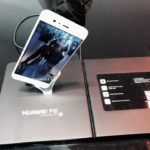Huawei’s new P10 and P10 Plus smartphones support Galileo, providing users with more precise positioning.
Huawei, the world’s third largest smartphone vendor, recently announced that its newest flagship smartphones are Galileo-enabled. This includes the company’s newly-launched P10 and P10 plus models, as well as its Mate 9, Mate 9 pro and Porsche Design Mate 9 smartphones. The Huawei phones are equipped with Broadcom Limited’s Galileo-enabled BCM4774 GNSS chipset.
“Our investment in providing people with a better location experience is another example of our commitment to delivering meaningful innovation,” says Huawei Head of Handset Portfolio and Planning, Europe, Arne Herkelmann. “With our Mate 9 and P10 families, all being Galileo-enabled, we ensure our customers have the most connected device no matter where they are.”
“We are excited to see our leading edge GNSS receiver chip, the BCM4774, which supports Galileo, being utilized in flagship smartphones from Huawei,” adds Broadcom Limited Senior Vice President and General Manager of Mobile Connectivity Products Division Michael Hurlston. “With the experience from our early work on BOC-modulated signals and its performance benefit for mass market devices, we anticipate Galileo support will soon become a de facto standard in smartphones and tablets and enrich the end-user experience of location-based services (LBS).”
As the new Huawei phones use the Android Operating System 7.0, called Nougat, application developers also have access to raw GNSS measurements directly from their Huawei phones. This feature opens up the possibility for higher accuracy and the deployment of algorithms traditionally restricted to more advanced GNSS receivers.
Multi-constellation access in the palm of your hand
In addition to Galileo, all of these phones support GPS, GLONASS and BeiDou, making Huawei one of the very first companies to take full advantage of today’s multi-constellation environment. Galileo is fully interoperable/compatible with these other GNSS systems, a combination that provides users with such improvements as stronger performance and service levels. With Galileo satellites working in conjunction with these other systems, there are more satellites available, meaning more accurate and reliable positioning for users. In particular, navigation in cities, where satellite signals can often be blocked by tall buildings, benefit from the increased positioning accuracy this provides.
We are very proud to see global handset vendors using Galileo so soon after the Declaration of Galileo Initial Services,” says GSA Executive Director Carlo des Dorides. “Today, with the booming use of context-aware applications, precise location information will be an increasingly important feature of smartphones, alongside camera and screen size.”
Des Dorides notes that the quick uptake of Galileo by major smartphone providers is important as LBS is the future of GNSS. According to the most recent edition of the GSA’s GNSS Market Report, well over 3 billion mobile applications in use today rely on positioning information. By 2020, more than 2 billion GNSS-enabled devices within the LBS sector will be shipped every year, and up to more than 2.5 billion units by 2023. By then, the overall installed base of GNSS devices will reach almost 9 billion units.
Industry collaboration pays off
It is because of the continued collaboration between the GSA and the smartphone and chipset sector that Galileo arrived onto a market ready and able to immediately start using it. In addition to Huwaei, such smartphone vendors as BQ and Sony also provide Galileo-enabled phones. More and more companies are being added every week, and an up-to-date listing of all available Galileo compatible products can be found at www.useGalileo.eu.
To further increase the level of Galileo integration, the GSA continues to work directly with device, chipset and receiver manufacturers. Through technology workshops, sharing Galileo updates, co-marketing efforts, and dedicated funding for receiver development projects and studies, the GSA is working with manufacturers to build an even better navigation experience.


Hi,
Could you please clarify for me something: Why in this post it is mentioned that Huawei P10 models have a Broadcom Limited’s Galileo-enabled BCM4774 GNSS (www.usegalileo.com mentiosn this as Galileo-ready) chipset when in the official specs of the phone HiSilicon Kirin 960 (not mentioned on http://www.usegalileo.com) is the chipset mentioned? The phone mentioned here was specially designed for GSA or is the normal phone that can be ordered in the stores?
I am interested in buying this phone for scientific reasons and I want to be sure that it is Galileo – ready and the chipset supports access to GNSS raw data.
I bought a Huawei p10 only for Galileo and it (Huawei p10) does not make it (Galileo)
My Huawei P10 actually sees GPS, Glonass and Beidou, but not Galileo. I bought for work. I feel cheated
Dear Sarunas,
Your P10 should be Galileo-ready. Did you try with the app GPS test? https://play.google.com/store/apps/details?id=com.chartcross.gpstest
Hi all, I thought to have the same problem but I was wrong.
@Florian: HiSilicon Kirin 960 is the CPU, not the GNSS chipset
@Sarunas & @Galileo GNSS: at the beginning I thought to have the same problem, but that’s not so fortunately. Galileo is enabled on the Huawei P10, but not using the app GPS test as mentioned above, or specifically not that app. I don’t know why GPS test mentioned above does not see Galileo sats. The correct app is GPSTest (same name, no spaces, this one): https://play.google.com/store/apps/details?id=com.android.gpstest&hl=it
Moreover, with this other app (Geo++ Rinex logger: https://play.google.com/store/apps/details?id=de.geopp.rinexlogger&hl=it) you can record Rinex data (2.11 or 3.03 data format).